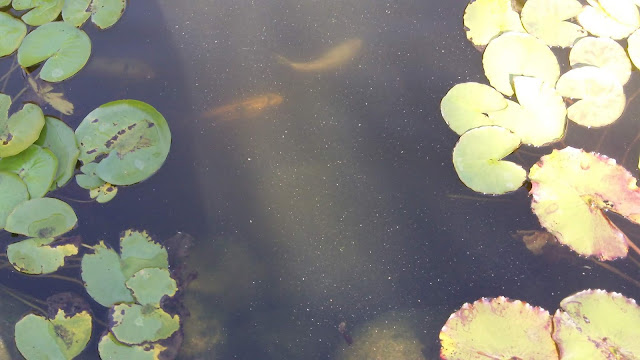Water Loss
When Is Water Loss Normal?
 |
| This pond has not had a spring cleaning yet. It has leaves, algae and aquatic plants that could all potentially dam the creek and cause leakage. |
You look outside at your pond and gasp... your pond needs water right away. Then your mind starts racing. "I'm sure I looked at it yesterday and it wasn't that low. What if there's a leak! It shouldn't need water it just rained." And on and on you go with the different scenarios in your mind.
Although leaks are possible, they're not as common as you might think! Water loss itself is very normal. And chances are if you're experiencing a weird loss in water, you probably aren't alone.
Here are some common circumstances that cause water loss (that are NOT leaks):
Relative Humidity
Relative humidity levels are a measurement of how much moisture is in the air compared to how much moisture the air can hold. If relative humidity levels are low, the air has the capacity to hold more moisture and it will wick the water right out of your pond, especially with the help of a little sunshine. Sunny days with a relative humidity in the 30s is a recipe for a lot of evaporation.
Spring/Summer Breezes
A light breeze may not seem like enough to cause water loss, but surprisingly it can! Wind wicks water right off the surface and from waterfalls and fountains.Plant Material, Leaf, or Algae Dams
If your pond hasn't been cleaned, you may have some leftover plant material or leaves causing a dam. This dam forces the water out of your pond and potentially a huge water loss. A good string algae bloom can do the same. Make sure to thin and divide aquatic plants that have gotten out of control while cleaning your pond in the spring. Also keep string algae in check with Remove Away.Make an Assessment -- Keep the Following in Mind
If you're still convinced that your water loss isn't normal and is in fact caused by a leak, then here are some general guidelines.
- IMPORTANT...Know how to properly check the water level in your pond. You may think you know, but there's more to it. Read about that here.
- Leaks are consistent over time. If you lose water for a while and then it stops and then starts again, that's most likely not a leak but weather/climate. Measure your water loss daily at the same time of day to check for consistent or inconsistent water loss.
- Turn off your waterfall or fountain and let the pond sit. Does it lose water? If it doesn't, then the leak is in your waterfall, creek, or plumbing. If it does, let the water continue to drop until it stops. Where the water stops dropping is your low edge, hole, or faulty skimmer opening.
- 95% of the time, leaks occur in the waterfall or creek. If you have determined that is where the leak is, find the liner edges first to make sure nothing is "spilling out." Settling and rock movement is common over winter. If nothing is leaking on an edge, start moving rock looking for holes. Often times, we find chipmunk damage under creeks and waterfalls.
The most common leakage issue we see is a low edge. Low edges are easily corrected. But don't assume you have a leak because you need to add water. Most people add water to their features weekly and sometimes more with adverse climate conditions.
Need more info? We're happy to advise, please visit us at our store.
Staci Wicker
Co-owner Cool Ponds




Comments